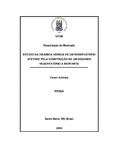| dc.creator | Andreis, Caren | |
| dc.date.accessioned | 2007-04-20 | |
| dc.date.available | 2007-04-20 | |
| dc.date.issued | 2004-07-23 | |
| dc.identifier.citation | ANDREIS, Caren. Study of the water balance of a reservoir affected by the construction of a second reservoir to the upstream. 2004. 123 f. Dissertação (Mestrado em Engenharia Agrícola) - Universidade Federal de Santa Maria, Santa Maria, 2004. | por |
| dc.identifier.uri | http://repositorio.ufsm.br/handle/1/7571 | |
| dc.description.abstract | The construction of reservoirs in sequence in the same basin has produced great problems in rural environment. It is supposed that reservoirs constructed in downstream of a second reservoir have their discharge affluent altered, or reduced, what generates conflict among proprietaries, since the proprietary of a reservoir in a downstream, will always be supposedly the harm one. The present paper has as objective to determine if, in fact, there are reductions and what the intensity of this reduction in the discharge affluent of a reservoir is (denominate here R1), that suffers influence of a second reservoir (R3), constructed in upstream. To come up to the methodology simulations were done through the use of the methodology of the water balance in reservoirs. The results show that, when the water is not taken off from R3 to irrigation, this do not influence practically anything in the water balance and the storage of R1. When the water is taken off from R3 to irrigation, this influences the storage volume in R1, but not up to the point of lacking water to irrigation of the proposed areas to the two reservoirs. When considered the dynamic capacity to determine the irrigation areas of R1 and R3, the greater total irrigation area was obtained in the simulation that considered the existence of two reservoirs, being the irrigation areas of these, determined from our dynamic capacities. In this case, the result of irrigation areas was 290 ha, more 90 ha than when only considered the static capacities in the estimation of the irrigation areas. | eng |
| dc.description.sponsorship | Coordenação de Aperfeiçoamento de Pessoal de Nível Superior | |
| dc.format | application/pdf | por |
| dc.language | por | por |
| dc.publisher | Universidade Federal de Santa Maria | por |
| dc.rights | Acesso Aberto | por |
| dc.subject | Recursos hídricos | por |
| dc.subject | Hidrologia | por |
| dc.subject | Bacia hidrográfica | por |
| dc.subject | Reservatório de água | por |
| dc.subject | Irrigação | por |
| dc.title | Estudo da dinâmica hídrica de um reservatório afetado pela construção de um segundo reservatório a montante | por |
| dc.title.alternative | Study of the water balance of a reservoir affected by the construction of a second reservoir to the upstream | eng |
| dc.type | Dissertação | por |
| dc.description.resumo | A construção de reservatórios em seqüência em uma mesma bacia hidrográfica tem gerado grandes problemas no meio rural. Supõe-se que reservatórios construídos à jusante de outro reservatório têm sua vazão afluente alterada, ou melhor, reduzida, o que gera conflitos entre os
proprietários destes, uma vez que o proprietário do reservatório a jusante, supostamente, sempre será o prejudicado. O presente trabalho tem como objetivo determinar se realmente há reduções e qual a intensidade desta redução na vazão afluente de um reservatório (aqui denominado R1), que sofre influência de outro reservatório (R3), construído à montante. Para tal, foram feitas simulações a partir da metodologia do balanço hídrico de reservatórios. Os resultados demonstram que, quando não há a retirada
de água do R3 para irrigação, este não influencia praticamente nada o balanço hídrico e o armazenamento do R1. Quando há a retirada de água do R3 para irrigação este influencia os volumes armazenados no R1, porém não a ponto de faltar água para irrigação das áreas propostas para
os dois reservatórios. Quando considerada a capacidade dinâmica na determinação das áreas de irrigação de R1 e R3, a maior área total de irrigação foi obtida na simulação que considerou a existência dos dois reservatórios, sendo as áreas de irrigação destes, determinadas a partir de suas capacidades dinâmicas. Neste caso, a área total de irrigação
resultante foi de 290 ha, 90 ha a mais do que quando consideradas as capacidades estáticas no cálculo das áreas de irrigação. | por |
| dc.contributor.advisor1 | Robaina, Adroaldo Dias | |
| dc.contributor.advisor1Lattes | http://lattes.cnpq.br/8629241691140049 | por |
| dc.contributor.referee1 | Pereira, Rudiney Soares | |
| dc.contributor.referee1Lattes | http://lattes.cnpq.br/9479801378014588 | por |
| dc.contributor.referee2 | Peiter, Márcia Xavier | |
| dc.contributor.referee2Lattes | http://lattes.cnpq.br/4072803412132476 | por |
| dc.creator.Lattes | http://lattes.cnpq.br/8634614129424776 | por |
| dc.publisher.country | BR | por |
| dc.publisher.department | Engenharia Agrícola | por |
| dc.publisher.initials | UFSM | por |
| dc.publisher.program | Programa de Pós-Graduação em Engenharia Agrícola | por |
| dc.subject.cnpq | CNPQ::CIENCIAS AGRARIAS::ENGENHARIA AGRICOLA | por |


